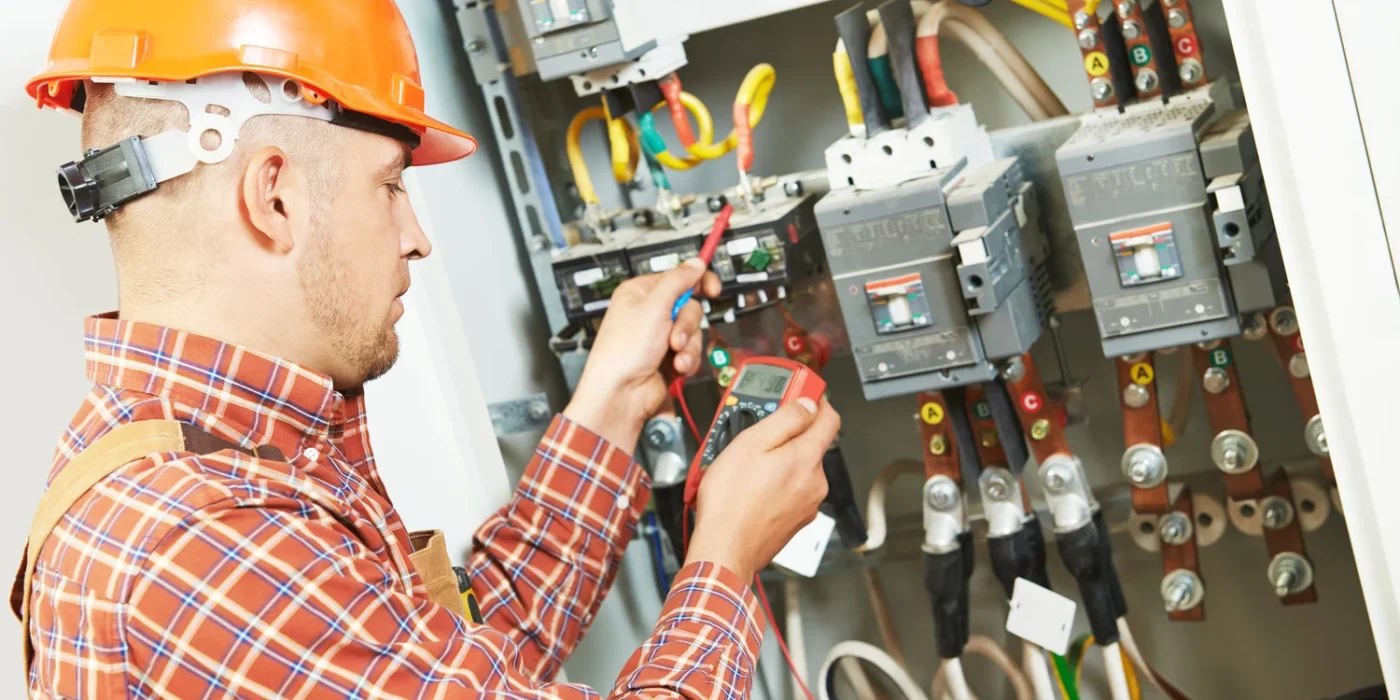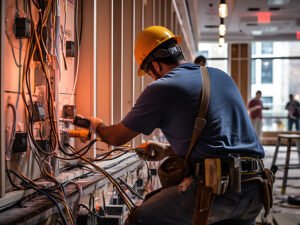M&E Surveys In The UK: How Mechanical & Electrical Inspections Protect High-Value Property Investments
In this guide, you’ll learn:
- What an M&E survey involves and why it’s essential for high-value property due diligence
- How it helps identify hidden issues in electrical, plumbing, and HVAC systems
- The role of M&E surveys in ensuring safety, compliance, and energy efficiency
- How regular inspections can extend system lifespan and protect overall property value
When investing in a high-value property, due diligence is everything. Whether you’re acquiring a commercial building, a luxury apartment block, or a heritage home, commissioning an M&E survey ensures your mechanical and electrical systems are safe, compliant, and performing efficiently.
Most property buyers focus on structure and aesthetics, but the building services that keep the property functional often go unchecked.
An M&E survey assesses the performance, safety, and compliance of key systems such as heating, ventilation, air conditioning (HVAC), electrical wiring, lighting, plumbing, and fire safety installations.
This guide explains what the surveys are, why they matter, and how they safeguard your property investment.
What is an M&E Survey?
M&E surveys (short for Mechanical and Electrical surveys) are specialised assessments that examine the building services within a property.
These systems are the backbone of any modern building, ensuring comfort, safety, and operational efficiency. This survey is carried out by qualified building services engineers or RICS-accredited partners with expertise in mechanical and electrical installations.
The survey evaluates system condition, performance, and compliance, identifying risks and recommending necessary upgrades or replacements.
Why Are M&E Surveys Important for High-Value Properties?
Unchecked systems = costly surprises. A proactive M&E survey prevents small faults from becoming major liabilities.
Luxury and high-value buildings often contain complex mechanical and electrical systems that support their premium functionality, like underfloor heating, intelligent lighting, high-capacity air conditioning, lifts, and advanced security networks.
Unchecked faults can escalate into safety, compliance and cost problems including:
- Expensive repairs or system replacements
- Fire or safety hazards
- Non-compliance with current building regulations
- Reduced property value or rental potential
- Operational downtime in commercial premises
A property’s beauty may be visible, but its reliability isn’t. M&E surveys reveal what the eye cannot.
Key Benefits of M&E Surveys for Property Investors
From compliance to cost savings, here’s how mechanical and electrical property inspections safeguard high-value assets.
1. Identifying Hidden Defects Before Purchase
An M&E survey digs deeper to uncover hidden mechanical or electrical faults, from outdated wiring and inefficient boilers to poor ventilation or overloaded circuits.
Early identification allows you to negotiate repairs or price adjustments before finalising the purchase.
2. Ensuring Safety and Regulatory Compliance
All M&E systems must comply with UK safety standards such as:
- BS 7671 (IET Wiring Regulations) for electrical installations
- Building Regulations Part L & F for energy efficiency and ventilation
- Gas Safety (Installation and Use) Regulations
The survey ensures your property meets these standards, protecting occupants and reducing legal or insurance risks.
3. Extending the Lifespan of Building Systems
Mechanical and electrical systems deteriorate over time due to wear and usage. Regular M&E inspections can identify maintenance needs and replacement timelines, extending the systems’ lifespan and preventing unexpected breakdowns.
4. Improving Energy Efficiency
With energy costs soaring and sustainability targets tightening, energy efficiency is a growing concern for property investors.
This survey highlights inefficiencies in systems like lighting, HVAC, and insulation, helping you:
- Lower operational costs
- Reduce carbon footprint
- Qualify for green building certifications or incentives
5. Protecting Asset Value and ROI
Efficient, compliant systems preserve market value, minimise downtime, and strengthen ROI, particularly in commercial or multi-tenant properties.
The real cost of neglect lies in what’s hidden: systems that fail silently until they cost thousands.
Before & After: The ROI of an M&E Survey
Issue Identified (Before) | Outcome After M&E Survey | Benefit to Owner/Investor |
Outdated wiring in a luxury flat | Replaced with BS 7671 compliant cabling | Prevented £25,000 in fire-safety remediation costs |
Inefficient HVAC system | Recalibrated and serviced for efficiency | Reduced energy bills by 18% annually |
Non-compliant fire detection system | Corrected and certified to the latest standards | Maintained insurance compliance |
Hidden drainage fault | Identified and repaired pre-purchase | Avoided structural damage and flooding risk |
Case Study: Chelsea Square, London
During a recent pre-purchase M&E and drainage survey at a high-value residence in Chelsea Square, London, our inspection identified several hidden issues, including a cracked storm gully, an intruding sealing ring restricting water flow, and a displaced interceptor trap that could have caused future flooding.
Through a detailed CCTV and condition assessment, we outlined a targeted repair plan totalling £3,000, which prevented potential damage and compliance risks estimated at over £20,000. Following our recommendations, the property’s systems were fully restored to regulation standard, ensuring safe, efficient operation for the new owner.
Details anonymised to protect client confidentiality.
What’s Included in an M&E Survey?
The scope of the survey varies based on the property’s type, age, and intended use, but it typically includes the following key components:
1. Mechanical Systems Inspection
Mechanical systems relate to comfort, air quality, and water supply. The survey covers:
- Heating systems (boilers, radiators, heat pumps, underfloor heating)
- Ventilation and air conditioning (HVAC systems, filters, air ducts)
- Plumbing and water supply (pressure, flow rate, hot/cold water distribution)
- Gas installations and compliance with Gas Safe standards
- Fire safety systems (sprinklers, smoke extraction fans, suppression systems)
- Lifts and escalators, where applicable
Surveyors assess functionality, safety, and condition, identifying outdated or non-compliant installations.
2. Electrical Systems Inspection
This part evaluates the property’s electrical infrastructure, including:
- Main incoming electrical supply and distribution boards
- Cabling, wiring, and circuits
- Lighting systems (internal and external)
- Power outlets and data systems
- Emergency lighting and backup power systems
- Lightning protection and earthing arrangements
3. Control and Automation Systems
Modern high-value properties often feature smart home or building automation systems that integrate lighting, heating, and security. The survey examines:
- Building Management Systems (BMS)
- Smart controls and energy monitoring devices
- Integration of systems for optimal efficiency
4. Energy and Sustainability Assessment
M&E surveys also consider how efficiently systems consume energy. Surveyors evaluate:
- Energy ratings and performance benchmarks
- Opportunities for renewable integration (solar panels, heat recovery systems)
- Potential savings through equipment upgrades or insulation improvements
5. Documentation and Reporting
After inspection, you’ll receive a detailed report listing:
- System condition and expected lifespan
- Defects and risks (with photographic evidence)
- Maintenance or replacement recommendations
- Compliance observations
- Cost estimates and priority ratings
How Often Should You Conduct an M&E Survey?
Include a survey in your pre-purchase due diligence, then repeat every 3-5 years, or annually for complex or commercial properties to maintain safety and performance.
M&E Surveys vs Standard Building Surveys
Aspect | Standard Building Survey | M&E Survey |
Focus | Structural and fabric condition | Mechanical and electrical systems |
Conducted By | RICS Chartered Surveyor | Building services engineer / RICS M&E specialist |
Includes | Roof, walls, floors, damp, defects | Heating, ventilation, electrics, plumbing |
Suitable for | Residential buyers | High-value, commercial, or complex properties |
Report detail | General condition | Technical, performance-based |
For high-value properties, combining both a building survey and an M&E survey offers the most complete picture of a property’s condition.
When Should You Commission an M&E Survey?
You should arrange a survey if:
- You’re buying or leasing a high-value or commercial property
- You’re planning major refurbishments or upgrades
- You need to verify compliance with current regulations
- You’ve experienced frequent system failures or energy inefficiency
- You want to establish a planned maintenance schedule
Why Choose Prime Property Surveys for M&E Surveys
Prime Property Surveys delivers comprehensive, RICS-compliant M&E surveys with clear, actionable insights, helping you protect and enhance your investment through precise reporting and expert guidance.
- Full compliance with RICS and British Standards
- Clear, jargon-free technical reports
- Priority repair guidance and cost forecasting
Your property’s structure may look solid, but its true value lies in the systems you can’t see. An M&E survey is your safety net, ensuring every critical system is safe, compliant, and cost-efficient.
Learn more about our M&E surveys and building surveys.
Frequently Asked Questions (FAQs)
What does M&E stand for in property surveys?
M&E stands for Mechanical and Electrical. It refers to the systems that keep a building operational, such as heating, ventilation, lighting, and power supply.
Are M&E surveys only for commercial properties?
No. They’re equally important for luxury residential or high-value homes that rely on complex systems.
How long does an M&E survey take?
The duration depends on property size and system complexity. On average, an M&E survey for a large property takes 1–3 days for inspection and a few days for report completion.
What is included in a mechanical and electrical property inspection in the UK?
An M&E survey UK assesses electrical wiring, plumbing, HVAC, and fire safety systems to ensure compliance, performance, and investment protection.
Can I combine a Building Survey and an M&E Survey?
Yes. Combining both gives a complete understanding, covering structural and system elements together.
How much does an M&E survey cost in the UK?
Costs vary based on property size and scope, typically ranging from £1,000 to £3,000 for standard high-value buildings. Large or specialised facilities may require bespoke pricing.




